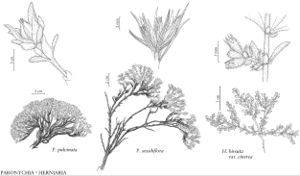Difference between revisions of "Paronychia sessiliflora"
Gen. N. Amer. Pl. 1: 160. 1818.
FNA>Volume Importer |
FNA>Volume Importer |
(No difference)
| |
Revision as of 20:10, 24 September 2019
Plants perennial, densely cespitose and mat-forming; caudex branched, woody. Stems erect to ascending, branched proximally, 5–25 cm, hirtellous. Leaves: stipules lanceolate to subulate, 2–3 mm, apex long-acuminate, often deeply cleft; blade linear-subulate, 4–7.5 × 0.5–0.8 mm, leathery, apex acute or shortly cuspidate-mucronate, very finely puberulent to glabrous. Cymes terminal, 3–6-flowered, congested, or flowers solitary. Flowers 5-merous, ± ovoid, with enlarged hypanthium and calyx narrowing distally, 3.6–5 mm, moderately pubescent with silky to stiff, antrorse to somewhat spreading hairs; sepals green to red-brown, midrib and lateral pair of veins prominent, lanceolate-oblong, 1.5–2 mm, leathery, margins whitish to translucent, 0.1–0.2 mm wide, scarious, apex terminated by awn, hood ± obscure, narrowly rounded, awn erect to somewhat spreading, 1–1.5(–2) mm, narrowly conic in proximal 1/2 with white, scabrous spine; staminodes filiform, 0.7–1 mm; style 1, cleft in distal 1/5, 1.4–1.5 mm. Utricles ovoid-oblong, 1.3–1.4 mm, densely pubescent in distal 1/2.
Phenology: Flowering summer.
Habitat: Dry, stony hillsides, summits, and sandstone mesas
Elevation: 700-3100 m
Distribution

Alta., Sask., Colo., Mont., Nebr., Nev., N.Mex., N.Dak., Okla., Tex., Utah, Wyo.
Discussion
Selected References
None.
